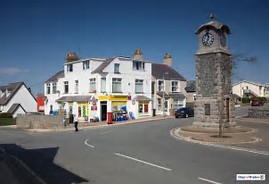
Rhosneigr war memorial is a clock tower approximately 8-9 metres high. It is composed of a number of materials such as limestone, slate rubble, brick and a hardwood door. This choice of materials is probably reflective of its seaside location, and exposure to the elements. As the memorial is a clock tower, the interior houses the mechanisms for the clock’s functions, and has a clock face on each side of the tower.
The clock tower centrally located in ‘The Square’ on the junction of the A4080 (Station Road) and Glan Y Mor Road.
In 2009 War Memorials Trust offered a grant of £2,500 towards a schedule of repairs which included: re-pointing of stonework in hydraulic lime mortar to make the structure watertight, as well as re-sealing the clock covers as they were also allowing water into the structure, the repair of fixings, and work to the interior of the memorial to improve the safety for carrying out maintenance of the clocks interior mechanisms.
This memorial is a civic clock tower which is believed to have been built c. 1922 by John Smith & Sons of Derby to commemorate those from Rhosneigr who were killed in World War I; a subsequent plaque was added after World War II commemorating those who were killed. It is currently maintained by part of the same group which produced it in the 1920s.
Among those commemorated who were killed in World War I are:
L. Cpl. W. Fred. Hahn,
Manchester Regt.
Lieut. Robert Th. M. Downie, 1916
Highland L. Inf.
Henry Gerald Walker
2nd K. O. Y. L. I.
Surgeon Godfrey A. Walker
R. N.
Pte. William J. Williams
17th R. W. F.
Lieut. Richd Glyn Lloyd, M.C.
9th K. Liverpools.
Pte. William J. Roberts, 1917
7th R. W.F.
Tho. J. Williams
8th South Staff’s.
William Roberts
Aust Imp. Force.
Robert Fair
14th Royal Warwicks
John Pritchard
7th R. W. F.
Vincent A. Holdsworth
4th Essex Regt.
John R. Jones
19th R. W. F.
Sergt Wm. Haselden Gate
S. African Mechanic.
Pte. Griffith Owen, 1918
4th R. W. F.
Lieut. Reginald A. F. Downie
Queens O. Cameron Hors.
Capt. Arthur Lloyd Jones M.C.
14th R. W. F.
Gunner Rowland Williams
R. F. A.
Pte. Robert Davies
10th Notts & Derby Regt.
Nid diwerth eu haberth hwy
meini ydynt mewn adwy. Meirionfab
(Priceless their sacrifice; and still
as boulders set, the breach they fill)
The inscription on the World War Two plaque reads:
Erected
in memory of the fallen
of this Parish in the
World War 1939-45
Arthur John Owen, 1941.
Chief Officer M. Navy.
Owen Jones, 1941.
Merchant Navy.
Arthur Price Owen, 1941.
Royal Marines.
Robert Goronwy Owen, 1942.
Master Mariner, M. Navy.
Thos. Richard Roberts, 1943.
Pte, 1st Batt. R.W.F.
Owen Henry Owen, 1944.
Major, 1st. Batt R.W.F.
Ernest T. Perry, 1944.
Pte. Royal Corps of Signals/
Griffith H. Griffiths, 1944.
Cdsman, Welsh Guards.
Frederick O. O. Taylor, 1945.
L.A.C., R.A.F.
They died that we may live.
Buont farw er mwyn i ni gael by w.
Further information
War Memorials Trust reference WM2711
UK National Inventory of War Memorials: 17398
If you have a concern about this memorial please contact the Trust on This email address is being protected from spambots. You need JavaScript enabled to view it.
War hero Admiral Sir Max Kennedy Horton is commemorated
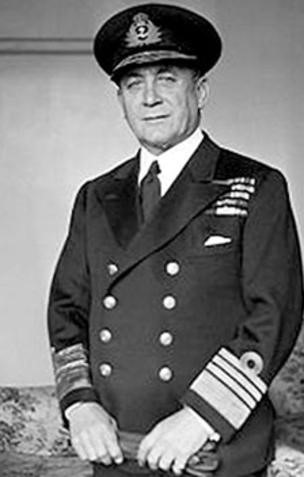
Admiral Horton changed the way Britain dealt with the threat of U-boats
A plaque has been unveiled on Anglesey to a World War II naval hero.
Historians say Admiral Sir Max Kennedy Horton arguably played as big a role in the Allied victory of the Second World War as Field Marshal Montgomery or Bomber Harris.
Yet in the village of his birth, Rhosneigr, he is barely even known.
Anglesey council and the Royal Navy unveiled a memorial at the local library to the man whose tactics defeated the Nazi U-boats.
Between 1942 and 1945 Horton played a key role in the Battle of the Atlantic, developing the aggressive tactics which defeated the German U-boats and ensured shipping lanes stayed open to provide Britain with vital arms and supplies.
As well receiving as British medals, he was honoured for his war efforts by France, the Netherlands, the Soviet Union and the USA.
Naval historian Charles McCain said Horton had a low profile back home despite mixing in high society.
'Radiated confidence'
"Admiral Horton had an extensive acquaintanceship throughout the British Empire. A man in his position would certainly have known a great many people," he said.
The plaque's unveiling will mark Rhosneigr and Anglesey's tribute to Admiral Horton who was one of Britain's leading wartime figures John Rees Thomas, Anglesey council's head of leisure and culture
"Yet he only entertained to the degree his rank and social position required.
"On several occasions during the war the King and Queen came to luncheon at his formal living quarters in Derby House, Liverpool.
"A letter he wrote afterwards to a friend clearly indicates he knew them already."
"But his background? Parents? His childhood? The source of his inner strength? His heroes? His inner life? Of Sir Max as a man? We have no idea."
"We do know this: the men and women under his command in Western Approaches never came to love him. They never came to like him. But they came quickly to respect him and even more, have the greatest confidence in him - for Sir Max radiated confidence."
Love of the sea
The second of four sons, his stockbroker father ran into financial trouble on the London Stock Exchange before Horton himself was even born in 1883.
Salvaging what money they could, the family relocated to north Wales, bought a hotel in Rhosneigr, and ran fishing and sailing holidays off Anglesey's west coast.
It was here that Horton developed his love of the sea, but possibly also his aloofness and introspection.

Winston Churchill called on Horton to turn the tide of the war at sea
John Rees Thomas, Anglesey council's head of leisure and culture, said: "He's a hard man to learn much about.
"The only biography of him, by Rear Admiral WS Chalmers, suggests that he was already an accomplished sailor by his very early childhood, but that he and his brother spent a lot of time playing alone, as they found it difficult to fit in with the language and culture of the island."
"But nevertheless we are proud to claim him.
"The plaque's unveiling will mark Rhosneigr and Anglesey's tribute to Admiral Horton who was one of Britain's leading wartime figures."
Horton joined the Royal Navy in 1898 aged 15.
By his early thirties he successfully led a fleet of experimental new weapons in World War I - submarines - earning the Distinguished Service Order with two bars.
More than twenty years later, during World War II, Prime Minister Winston Churchill turned to Horton when the Battle of the Atlantic appeared almost lost.
High-risk strategy
In the winter of 1942/43 German U-boats were sinking an average of four merchant ships a day, and at one point it was estimated that Britain would run out of food in three weeks unless the blockade could be lifted.
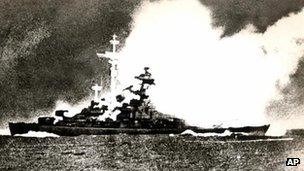
Despite the sinking of the Bismarck in 1941 Britain was suffering heavy losses in the north Atlantic
Horton revolutionised the tactics used on Atlantic convoys, moving away from strictly defensive escort formations to take the fight to the U-boats even if it created greater risk in the short-term.
This high-risk, high-reward strategy meant that under Horton's command merchant shipping losses actually went up.
But the number of U-boats destroyed reached such levels that the Germans withdrew the remains of their fleet from the north Atlantic rather than face annihilation.
However, Mr McCain believes it was not just the change of tactics which brought about such a reversal in fortunes in the Battle of the Atlantic, but Horton's strong leadership and attention to detail.
The stress of a life in command took its toll on Horton, who died in 1951 before realising his ambition to retire to the south of France.
His commemorative plaque was unveiled by the Naval Regional Commander for Wales and West of England, Commodore Jamie Miller, at Rhosneigr Library on Sunday.
The Blackburn Botha Disaster Memorial
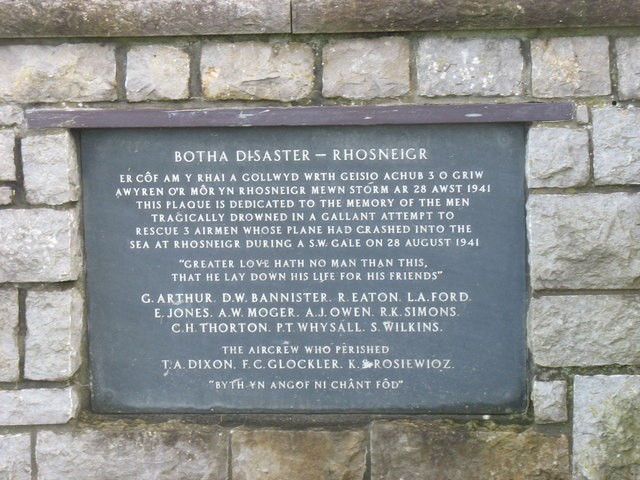
This stone, erected on the lawn of the Rhosneigr Fire Station in 1991, is a memorial to the 11 men - locals, Royal Artillery and RAF Valley personnel - who, together with the 3 aircraft crew, were lost when, in a fierce gale on the 28th August 1941, Blackburn Botha L6417 of Air Observer School, West Freugh, (near Stranraer), crashed into the sea just short of the beach at Rhosneigr. Three boats were launched each of which capsized drowning its crew. George Cledwyn Arthur (29) was the village bobby and E Jones,(whose son Arthur was the moving spirit behind setting up the memorial), was a Coastguard. The five RA men, a subaltern, a warrant officer and three gunners are buried side by side at Llanfaelog New Cemetery. Two boys also put to sea in a dinghy in an effort to reach the aircraft, but were unable to save the crew who were swept away by the waves. Their dinghy overturned but they were fortunate in being rescued by people from the beach. The two lads, Derrick Baynham and John Wood, were awarded the George Medal.
